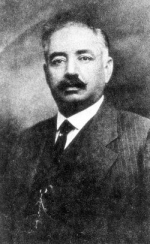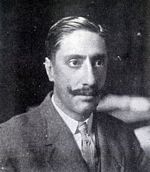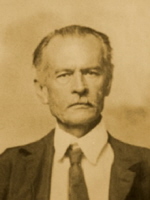Provisional Estado de Sonora notes
The 27 August decree also allowed the Treasury to issue provisional notes (billetes provisionales) while the definitive issue was being printed. Originally there were to be 200,000 pesos, with no indication of series and made up in the same way as the definitive series, but another decree (núm. 23), on 16 October, provided for a second, third and fourth seriesAlcance to El Estado de Sonora, 19 October 1913. That the original decree authorised only 200,000 pesos and included detailed provisions for their redemption (in exchange for the definitive issue) and destruction is further evidence that the government expected the definitive series to be quickly available.
These provisional notes carried the printed names of José María Maytorena as Governor and Juan Sánchez Azcona as First Official (Oficial Mayor Encargado de la Secretaría (O.M.E.de la S)). The $1 has the printed signature of Carlos E. Randall as Treasurer General (Tesorero General), whilst higher values had, for the first series, the hand-written signature of Agustín Lewels as Accountant in charge of the Treasury (El Cont. E. de la Tria. Gral.) and, for the later series, first Randall and then Luis Sotomayor as Treasurer General. On the third and fourth series $5 and fourth series $10 the signature and title of the Interventor Enrique Astiazarán, appointed on 24 September 1914, also appear.
|
A political moderate, Maytorena had originally backed Bernardo Reyes and then Madero. In 1910 he organised the Junta Revolucionaria Mexicana in Nogales, Arizona and became one of Madero’s earliest disciples in Sonora, as he claimed, ‘to defend its sovereignty’. He was elected governor but after Huerta seized the presidency, on 22 February 1913 he left for a six-month sabbatical in the United States, returning on 4 August. Maytorena was always at odds with Carranza and on 23 September 1914, counting on the support of Villa, he disowned Carranza. His faction fought against Plutarco Calles in Agua Prieta and Ángel Flores in Navojoa. On 1 October 1915 Maytorena handed over the governorship to Carlos Randall and left for the United States. He died on 18 January 1948. |
|
|
When Madero was assassinated he fled first to Cuba and then to the United States, finally joining Carranza in Coahuila. Shortly afterwards, Carranza sent him to Sonora, where Maytorena designated him Secretario General de Gobierno. He renounced his post of Oficial Mayor on 9 January 1914 on being named the Constitutionalist representative in Europe and in the following decade held a series of political and diplomatic posts. From 1922 till his death in 1938 he went back to journalism. |
|
|
On his return to Guaymas he founded, with Maytorena and Victor M. Venegas, the first Club Reyista in Sonora, originally not as an anti-reelection movement but to support Reyes against Corral in the vice-presidential election. Randall was the club’s treasurer whilst Maytorena was president. Next he supported Madero. Randall accompanied Maytorena on his sabbatical to the United States. When they returned he supported Maytorena against Carranza and was named governor by Villa on 1 October 1915. On 26 November 1915 he left for the United States but returned in 1920. He died in Tucson on 2 July 1929 and is buried in Guaymas. |
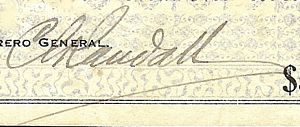 |
|
Agustín Lewels was a businessman who was based for several years at Altar and Hermosillo. He was in charge of the Treasury, as Contador with the functions of Tesorero General Interino, for four months during 1913. On 11 August the newly reestablished governor, Maytorena, told him to hand over his office to the Oficial Primero, Luis C. CanoAGHES, Fondo Oficialidad Mayor, tomo 2965, Maytorena to Lewels, 11 August 1913, and on 14 August Lewels wrote his resignation, stating his desire to help the Constitutional cause in another stateAGHES, Fondo Oficialidad Mayor, tomo 2965, Lewels to Maytorena, 14 August 1913. Lewels was the junior partner in the firm of Richard Fleischer & Company, a men’s clothing and furnishing goods store in Nogales, and at the end of 1914 bought out Mr. Fleischer’s interest in the businessThe Oasis, 31 December 1914. This store was housed in the Breen Building, on Morley Avenue, adjacent to the Sonora Bank & Trust Company’s offices. |
 |
| Luis Sotomayor was Administrador de Rentas in Alamos and instructed to move to Hermosillo in August 1913AGHES, Fondo Oficialidad Mayor, tomo 2965 telegram Maytorena, Hermosillo to Sotomayor, Alamos, 10 August 1913. Randall temporarily handed over his office as Treasurer to Contador Sotomayor on 26 March 1914 and Sotomayor stood in for him for six months, handing over to Jesús Ramos in turn in December 1914AGHES, Fondo Oficialidad Mayor, tomo 2993. The 29-page documentation of the handover, which took from 15 to 22 December, provides a wealth of data. |  |
| Enrique Astiazarán, like Randall, was a member of a petit bourgeois family from Guaymas. He was appointed by Sotomayor as Interventor on 24 September 1914AGHES, Fondo Oficialidad Mayor, tomo 2993. | 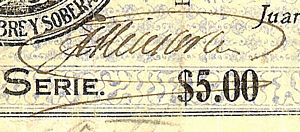 |
These provisional notes were being printed by 2 SeptemberAGHES, Fondo Oficialidad Mayor, tomo 2971. The printing press was in the Palacio de Gobierno. On 3 September it was reported that Maytorena had temporarily suspended the issue, because of disturbances amongst his troops who objected to being paid in such money but the suspension, if any, was temporary until certain modifications had been introducedEl Imparcial, Tomo XXXV, Núm. 7,090, 4 September 1913; El Diario, 4 September 1913 and the notes began to circulate on 11 SeptemberAGHES, Fondo Oficialidad Mayor, tomo 2971. However, they are recorded as appearing in Cananea on Thursday, 4 September (Douglas Daily Dispatch, 6 September 1913). By 16 September the notes had reached NogalesDouglas Daily Dispatch, 17 September 1913. The first series was completed on 17 September. The printers were working on the other three series even before the relevant decree and after working day and night for thirty-three days the job was completed by 30 OctoberAGHES,. By this time they were desperately needed as coinage had virtually disappeared, the Banco de Sonora and Banco Nacional de México in Nogales were unwilling to cash their own notes and American banks on the border were refusing to accept Mexican paper currency at any price.
However, Americans in Sonora were not keen on being forced to accept the notes. On 3 September the U.S. vice consul at Nogales, Frederick Simpich, informed the State Department that American and other foreign merchants under the protection of his Consulate and conducting business in this district had applied to him for advice as to whether they should accept the fiat money, thereby sustaining severe losses, or refuse it and thus incur the possibility of a prison sentence. As the matter was of grave importance to all foreign merchants in Nogales, Magdalena, Nacozari and Cananea he requested an urgent replySD papers, 812.5157/7. On 18 September the State Department replied that it would wait to receive a copy of Maytorena’s decree. If, in the meantime, any effort was made to force this money upon American citizens, he should protest unofficially but urgently to the so-called Constitutionalist authorities against such actionibid.. On 21 September the consular agent in Cananea, Charles L. Montague, was told by his State Department that as under the Mexican constitution only the federal authority could issue currency the American government did not consider that Sonora had the right to force acceptance of its fiat money. Montague was instructed to inform all Americans that they need not accept the money and, if necessary, should refuse it but he received short shift from the Sonoran governmentAGHES, Fondo Oficialidad Mayor, tomo 2971 telegram Ignacio Bonillas, Cananea, to Juan Sánchez Azcona, Hermosillo, 21 September 1913. However, the Cananea Consolidated Copper Company accepted itAGHES, Fondo Oficialidad Mayor, tomo 2971 telegram Trinidad García, Presidente Municipal, Cananea, to Maytorena, Hermosillo, 23 September 1913.
The next day, 22 September, Simpich, at Nogales, Sonora, also received instructions from the State Department to notify Americans in Sonora that they need not accept this state paper money, and the consul wired to all he could reach that he had received such an instructionThe Oasis, 27 September 1913. The following day Sánchez Azcona met Simpich in Nogales and assured him that Carranza was opposed to any policy that would compel Americans in Sonora to accept the state’s currencyThe Bisbee Daily Review, 24 September 1913; The Border Vidette, 27 September 1913: Douglas Daily International, 28 September 1913.
Carranza's attitude
On 9 March 1914 Carranza’s Secretario de Gobernación, Rafael Zubarán Capmany, complained about the independence shown by the authorities in Sonora, including the issue of paper money, and told Maytorena to bring his dispositions in line with those of the Primer Jefe, except where the state’s constitution allowed otherwiseJMM papers, box 4, folder 2.
On 20 July the Sub-secretario F. F. Villarreal wrote to Maytorena asking for details of the number of notes issued to date and telling him that Carranza forbad him making any further issues, an accusation Maytorena vehemently deniedJMM papers, box 4, folder 5.
Seven days later General Salvador Alvarado suggested to Carranza that he order the withdrawal of the Estado de Sonora notes and disown the new 50c notes that the state was issuingJMM papers, box 4, folder 5, intercepted telegram Alvarado to Carranza, 27 June 1914 (on 13 July, Maytorena, referring to intercepted telegrams in a letter to Coronel Acosta, had denied that he was issuing any new notes or that his printing press was constantly producing 50c notes JMM papers, box 4, folder 5) and the following day Carranza replied that he would shortly publish an appropriate decreeJMM papers, box 4, folder 5, intercepted telegram.

